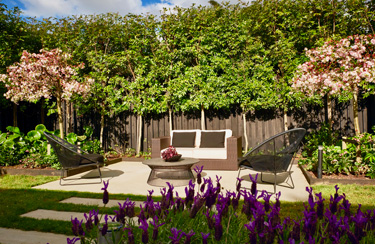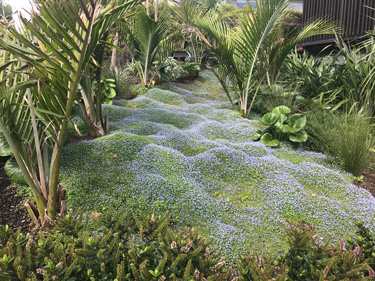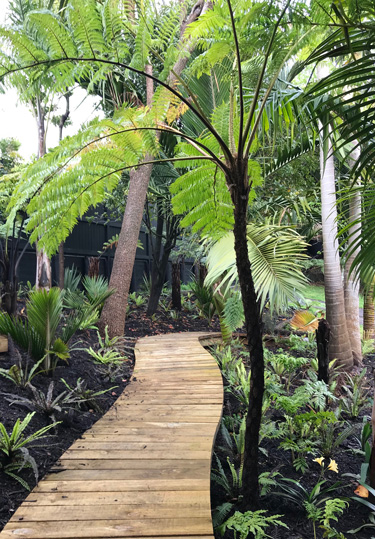Creating spaces
Val loves it that her work is both indoors and out. Some days she’s in her studio working on her hand-drawn garden plans. Other days she’s out visiting clients in their gardens or mucking in with the landscaping team when it’s time to plant. To Val, a great design focuses not only on the way a garden looks, but how it makes us feel. We caught up with her during her busy spring schedule.
GG: What is it about your work that you find most rewarding?
Val: The thing I love about gardens is that they are fluid. The shapes and light are ever changing as the garden grows and with the seasons. I love creating spaces that you can use differently. Even a transitional area can be stunning.
GG: What things do you think about first when planning a new garden?
Val: How is the space going to be used, how does it sit within the wider landscape and what is the relationship between the outdoor space and building?
GG: Do you have a design signature?
Val: I don’t think so. I try my very best to listen to what the client wants. I want to be versatile and brave, express the client’s personality, respect the architecture of the house or building. I don’t want to be known as, “Oh... she does tropical gardens” or “She likes roses.”
GG: How much are you influenced by natural plant communities when designing planting plans?
Val: Right plant, right place is really important. Enhancing and working with the existing environment is a fantastic opportunity. A design needs to sit symbiotically and looking around the area gives you a clear indication of what will work. Using native plants enriches the garden’s relationship with birds and bees.
GG: How do today’s environmental issues affect your design?
Val: Being able to create gorgeous designs in sympathy with the environment is key for me and as a designer it’s my responsibility. The weather has a huge impact on a design. The wind, our hot summers and the lack of rain from March through to May or June has an enormous effect. People often turn off their irrigation as the temperature drops in autumn, but the lack of water reflects on the health of the plants. One of my ‘things’ is introducing edibles and bees into gardens. It doesn’t have to be a huge area to achieve this. I often add espalier fruit trees on blank walls or at the end of a planter. Edible hedging is another way to incorporate food plants into a design. I also encourage composting, even in a small garden.
GG: What would you consider to be your biggest design challenges?
Val: Budget, vision, and perception of value. It’s easy to underestimate how much time is involved. Low maintenance is very often one of the first requirements expressed by clients, but I am convinced that if you do the ground work initially and make sure you have good soil, good plants, feed and mulch, then maintaining a garden will be straight forward. More importantly, the health of the plants will be excellent. It is especially important to consider size of the space when choosing plants for a low maintenance garden.
GG: How much are your designs influenced by the dimension of time?
Val: A lot! Gardens are always changing, there is so much to consider - the ultimate size of plants and their growth rates are so important. I want my gardens to last as long as their owners want them to. Sometimes rapid results are the most important thing. Other designs are for the longer term. Over time, there are alway things you can do to make changes or change a look.
GG: What are some of your favourite plants?
Val: My own garden is so diverse, I think I am a plant collector! I love anything edible, flowers, colour, texture. Gardenia is one of my staples; it can sit within any combination, and always looks good in the Auckland climate if kept watered and fed. Convolvulus cneorum is a great easy- care shrub, which grows gracefully below trees or over a retaining wall, providing excellent contrast and colour with its silver foliage and masses of white flowers. Loropetalum is another favourite. Its colour is gorgeous and the leaves float so gracefully. Titoki trees are wonderful all rounders. I love their intricate leaves and the colour of their bark. They’re well behaved evergreens with low leaf litter so they are easy to live with and ideal for small gardens.
And they provide food for the birds.
GG: What fabulous plant combinations have you discovered?
Val: Wow, there are so many! A few I love are: Loropetalum ‘Plum Gorgeous’ with Acorus gramineus, Ligularia reinfomis with Asplenium bulbiferum, Phormium ‘Dark Delight’ with Hebe 'Santa Monica’, and Cotinus ‘Grace’ with Miscanthus ‘Morning Light’.
GG: Have your travels influenced your design?
Val: Yes, particularly French courtyards, English lawns with mature trees, Italian pots with citrus and Mediterranean colours.
GG: Who are the garden designers that most inspire you?
Val: Trish Bartleet (Auckland designer) is an absolute rock star! I have learnt so much from her.
GG: Do you have any favourite gardening tools or accessory?
Val: Secateurs for clipping.
GG: What would be your own dream garden?
Val: I’d love about an acre with sweeping lawns and mature deciduous trees. It would also feature an orchard, an edible courtyard with planters filled with vegetables, herbs and fragrant delights. It would also have a pergola with huge beams with grapes dripping over it and a big outdoor dining area set within a layered garden.
GG: What’s your advice for a beginner gardener?
Val: Go with your heart, enjoy the process. Don’t limit yourself. Read about the plants and look at pictures. You never stop learning! Always start with good soil and mulch, mulch, mulch! Feed with good quality liquid fish fertiliser.

1-Nov-2019

Val Puxty

Val chose pleached titoki and flowering crab apple trees for this formal inner city garden

A river of Isotoma beneath a grove of Nikau palms

A wooden board walk wends its way thorough the fernery-palmery

